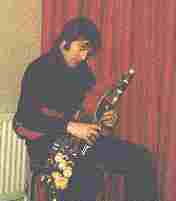 History
HistoryAbout Uilleann Pipes
 History
History
There are references to Piping in Ireland going back 13 Centuries. The earliest of these references are in the ancient law tracts and annals. There are carved depictions of early pipes on some Celtic Crosses (probably 10th Century) and from the 15th Century onwards the references are more frequent. Before the 18th century all references to pipes relate to mouth-blown instruments.
The distinctively Irish form of bagpipe, the Union or Uilleann Pipes, is believed to have originated about the beginning of the 18th Century, although no exact source of development has been found. It is thought the name 'Union Pipes' refer to the union of sound produced by Chanter, Drones, and Regulators. Another theory is that 'Union' is a corruption of the Irish word 'Uilleann' which means elbow. This fits the change from mouth blown to bellows driven Pipes, the bellows being powered by the elbow. The handsome Piper in the picture is Me, taken in 1975, playing my first Set of Pipes. Now that's History !
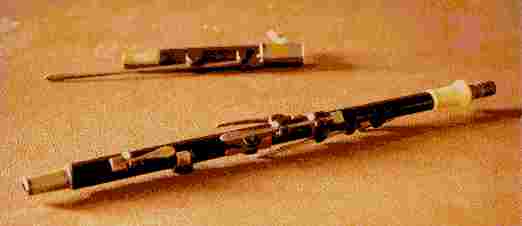 There are a number of fine sets surviving from the mid 18th century onward.
Most of these sets are pitched in low keys like B and B flat.
There are a number of fine sets surviving from the mid 18th century onward.
Most of these sets are pitched in low keys like B and B flat.
The picture shows a beautifully elegant Coyne B Chanter from about 1830.
Piping was at its height in pre-famine Ireland (pre 1847) but the social effects of that famine, (not to mention death and emigration), led to a decline in piping. By the beginning of the 20th Century the last of the professional traveling pipers in Ireland were mostly destitute, finding refuge in workhouses.
 Pipe-Makers in the U.S.A.
Pipe-Makers in the U.S.A.
Michael Egan first set-up his business in Liverpool, England and then later in New York, U.S.A., and is famous for the sweet tone of his low pitched pipes, highly valued today..
Probably the most famous and innovative were the Taylor brothers from County Louth, who set up in Philadelphia and made many fine sets. They are best known for the large flat Regulator keys and for what is now termed Concert 'D' sets. Finding the sound level of the older type of Pipes too quiet for playing in the large concert halls of America, they enlarged both the size of bore and the finger holes on the chanter, swelling the volume of sound. See picture for the example of my Taylor Set with four Regulators and four Drones.(photo from 1975)
As a result of a flourishing Irish population in America, music found its way back to Ireland in the form of musicians coming home, recordings like Patsy Touhey's, and instruments like the sets made by Taylors. Taylor Sets were copied by many Irish makers in the 20th century (mostly the internal bore and tone hole patterns).
Sets of Uilleann Pipes
Generally a set comprises
Bellows Bag Chanter Drones (3) Regulators (3)
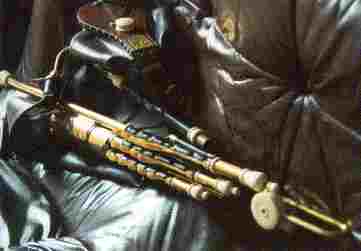 Unlike most other bagpipes throughout
Europe, the bag or air reservoir on the Uilleann Pipes is inflated by means of a bellows
operated by the elbow of one arm with the bag being held under the other arm.
Unlike most other bagpipes throughout
Europe, the bag or air reservoir on the Uilleann Pipes is inflated by means of a bellows
operated by the elbow of one arm with the bag being held under the other arm.
The Chanter is the main melody instrument and has a range of two octaves. A two octave range is very unusual among bagpipes.
The Drones, (usually three - base, baritone & tenor) when turned on, supply a continuous ‘drone’ accompaniment to the melody.
The Regulators are keyed chanters, usually three on a full set, which are operated by the musician when various chords as accompaniment are required.
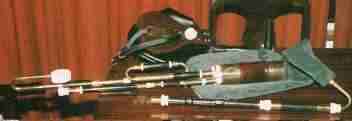 A Bag Bellows and Chanter alone are often called A Practice Set.
When Drones are added to a Practice Set is is called A Half Set. The picture shows an
example on a table.
A Bag Bellows and Chanter alone are often called A Practice Set.
When Drones are added to a Practice Set is is called A Half Set. The picture shows an
example on a table.
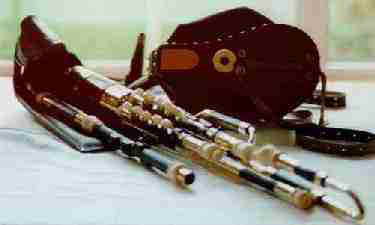 The addition of two Regulators is sometimes called a Three Quarter
Set and the photo on right shows an example of this. The third Regulator (bass) is omitted
on this Set.
The addition of two Regulators is sometimes called a Three Quarter
Set and the photo on right shows an example of this. The third Regulator (bass) is omitted
on this Set.